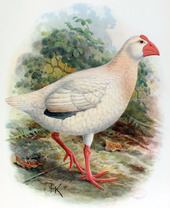Kingdom Animalia Order Gruiformes Genus Porphyrio Higher classification Swamphen | Phylum Chordata Family Rallidae Scientific name Porphyrio albus Rank Species | |
 | ||
Similar Bird, Tahiti rail, Swamphen, Rodrigues rail, Laysan rail | ||
The Lord Howe swamphen or white gallinule (Porphyrio albus) is an extinct species of rail that was endemic to Lord Howe Island, Australia.
Contents
Taxonomy
This bird was first described by John White in his Journal of a Voyage to New South Wales (1790), which also contained an illustration. It was not uncommon when the bird was first described, but was soon hunted to extinction by whalers and sailors.
There are two skins of the bird in existence, one in the collection of the World Museum in Liverpool and the other in the Naturhistorisches Museum Wien in Vienna. There are also several paintings, and some subfossil bones.
Description
It was similar to the purple swamphen, but with shorter and more robust legs and toes. Its plumage was white, sometimes with a few blue feathers, and it was probably flightless, like its other close relative the takahe. Similar, entirely blue birds were also described, but it is not clear if they belong to this species or are simply purple swamphens (which can also be found on the island). The feathers on the two extant skins are white.
